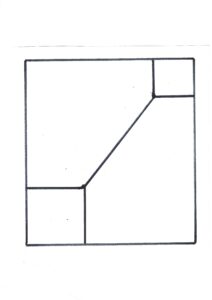
The key feature is that our “defenses” are lowered—the barrier between quad four and quad one is not quite as strong. A new idea is allowed to emerge. We have known about this phenomenon for many years – it is called “incubation” and has often been depicted regarding the occurrence of major breakthroughs in both the sciences and the arts (Ghiselin,1985). I like to think of this as a wonderful stew that is simmering on the back burner (Quad Four) of our stove. We are not attending to it, but the stew is getting better and better. Finally, we notice it and bring it to a front burner (Quad One). We dish it up for our own enjoyment and that of other people.
Large Quad One/Large Quad Four
This scenario offers “fertile ground” for personal growth and interpersonal insight. A large amount of material remains unknown in Quad Four, yet there is a yearning—often a naïve enthusiasm—to bring this material to the surface and to share it. If the small Quad One and large Quad Four is the assumed starting point for a typical psychotherapy session, the large Quad One and large Quad Four represents this session when it is “cooking”—there is still much material that remains unconscious, but there is also much material that has been brought to the surface and analyzed.
 This scenario also seems appropriate for human relations training program—which Joe Luft has conducted for many years—and which has served as a base for much of his work on the Johari Window. In human relations programs, participants often are amazed and delighted (after the initial discomfort fades away) to discover new things about themselves not only from the feedback they receive from other participants (Quad Two material to Quad One), but also from other exercises that are conducted during the program that are more oriented to personal growth than to interpersonal sensitivity. This shift (or expansion) in focus from interpersonal to intrapsychic awareness represented a major (and quite controversial) transformation in the human relations movement in North America.
This scenario also seems appropriate for human relations training program—which Joe Luft has conducted for many years—and which has served as a base for much of his work on the Johari Window. In human relations programs, participants often are amazed and delighted (after the initial discomfort fades away) to discover new things about themselves not only from the feedback they receive from other participants (Quad Two material to Quad One), but also from other exercises that are conducted during the program that are more oriented to personal growth than to interpersonal sensitivity. This shift (or expansion) in focus from interpersonal to intrapsychic awareness represented a major (and quite controversial) transformation in the human relations movement in North America.
Whereas the traditional T-groups of the 1960s and 1970s tended to focus on interpersonal feedback and disclosure, the “encounter” groups (especially on the West Coast) tended to incorporate a series of exercises that required very little interpersonal interaction, but extensive intrapsychic reflection. John and Joyce Weir have similarly conducted workshops that invite participants to take full ownership for all of their own interpersonal perceptions and feelings and to explore their own sources of feelings through participation in exercises that encourage a regression to more primitive states of being.








